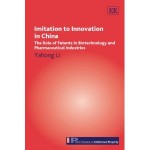“In every crisis, there is opportunity” ~Chinese Proverb
With a GDP of more than $8,000 billion, China is poised to become the world’s third-largest pharmaceutical market next year – up from number eight in 2006. The $24.5 billion pharmaceutical market is expected to swell to $68 billion to $78 billion by 2013, leaving it behind only the United States and Japan. Multinationals currently hold 30 percent of the market with local drug companies taking 70 percent.
In addition, under the 2006 Science and Technology Plan, China has set a goal of investing 2.5% of its GDP in research and development, a quadrupling of expenditure. What remains to be seen is how intellectual property rights — and their enforcement — helps or harms these efforts.

This book not only looks at the innovation capacity and infrastructure of China’s biotechnology and pharmaceutical industries, it also put this in context of the role of the Chinese government in promoting these innovations. The Chinese government perceives biotech and pharmaceutical industries as strategic sectors and treats them as the top priority in the nation’s current development plan, the 11th Five-Year Plan (2006-2010). In addition to preferential tax schemes and other favorable policies, the Chinese government has also set very clear targets for these industries. For example:
- Developing and commercializing 10-15 innovative drugs and vaccines with Chinese-owned IPRs for the treatment of major, acute infective diseases or chronic severe diseases.
- Marketing five chemical synthetic finished drugs to US or EU countries.
- Fostering five large-scale pharmaceutical groups with sales revenue of more than five billion yuan ($640 million), promoting 10 pharmaceutical distributors with over three billion yuan ($384 million) sales revenue, and helping five domestic pharmaceutical enterprises evolve into international enterprises.
The Chinese government is a major funding source for R&D in the biotech and pharmaceutical industries. Through various programs, the government has invested $205 million from 1996 to 2000 and $731 million from 2000 to 2005. The figure is expected to reach $8.8 billion in 2010.
After going through case studies of patent lawsuits, the author notes that after 1993, the patent law was amended to allow for the patenting of chemical substances and pharmaceuticals. Since then, China’s biotechnology and pharmaceutical industries have been filing (and obtaining) more patents and fighting more patent infringement battles. This demonstrates the connections between patent law and patent activities. The author then explores “does an increase in patent filings or litigation mean more and higher-level innovations?”
However, the newly amended patent law seems to reverse the trend of the last two rounds of amendments and opts for a more protectionist approach. That is, it gives more attention to the protection of public interests and public health rather than merely increasing protection of patent rights. The author posits that this come from a genuine realization from Chinese scholars and government officials that while the protection of patents can promote innovation, patent protection must be limited to the extent that the balance between patent right holders and public interests can be maintained. The question is, however, how can these two seemingly contradictory objectives be reconciled?
With China’s pharmaceutical market valued at $76–$86 billion (based on 2008–2013 IMS Health estimates), the key question is how much of the market will be supplied domestically and to what extent will the projected 23–26% compounded annual growth rate (2008–2013) for China’s pharmaceutical market be an engine for growth for China’s domestic pharmaceutical companies.
About the Author
Dr Yahong Li is an Associate Professor and Director, LLM Program in Intellectual Property and Information Technology, Faculty of Law, University of Hong Kong. She is also an author of International and Comparative Intellectual Property: Law, Policy and Practice (LexisNexis, Butterworths 2005).
Imitation to Innovation in China: The Role of Patents in Biotechnology and Pharmaceutical Industries (New Horizons in Intellectual Property) is available through Amazon.


[…] This post was mentioned on Twitter by China IPR Helpdesk, PriorSmart. PriorSmart said: From patentbaristas.com- "Book Review Monday: Imitation to Innovation in #China" – http://bit.ly/b9JjTl #patent #japan […]
Great comments, what I could make of it. I think my browser is not working.
Great comments, what I could make of it. I think my browser is not working.